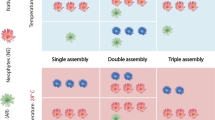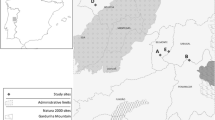Abstract
Most Mediterranean wetlands are overexploited and degraded by different factors and are especially vulnerable to alien and invasive species. Currently, there is still a lack of knowledge on certain aspects of plant invasions, especially from an applied point of view, as key tools in restoration and conservation programmes. In this sense, Cortaderia selloana has showed a rapid expansion in the western Mediterranean Basin, threatening habitats of special interest such as wetlands. A comparative study between C. selloana and Saccharum ravennae, a representative plant of Mediterranean marshlands, was carried out to characterize the biological pattern that has made C. selloana a potential threat. The role of these plant species in soil seed banks and the potential competitive displacement of S. ravennae were evaluated through seed germination and viability tests under accelerated ageing conditions and seedling root development, considering seed morphological characteristics, seed maturity and plant sexuality as influential factors. Additionally, the potential allelopathic effects of C. selloana leaves on S. ravennae seed germination were evaluated. The study found differences between the species in all the tested parameters, seed morphology, germination response and longevity, adsorption isotherm curves, and allelopathic effects. All these factors establish a complex interaction that contributes to the proven invasive character of C. selloana. These results provide useful data for eradication and management programmes.






Similar content being viewed by others
References
Bacchetta G, Dettori CA, Mascia F, Meloni F, Podda L (2010) Assessing the potential invasiveness of Cortaderia selloana in Sardinian wetlands through seed germination study. Pl Biosyst 144:518–527
Basnou C (2006) Cortaderia selloana, DAISIE project. Available at http://www.europe-aliens.org/pdf/Cortaderia_selloana.pdf (accessed November 2017)
Brunel S, Schrader G, Brundu G, Fried G (2010) Emerging invasive alien plants for the Mediterranean Basin. EPPO Bull 40:219–238
Domènech R, Vilà M (2008) Cortaderia selloana seed germination under different ecological conditions. Acta Oecol 33:93–96
Doménech-Carbó A, Montoya N, Soriano P, Estrelles E (2018) An electrochemical analysis suggests role of gynodioecy in adaptation to stress in Cortaderia selloana. Curr Pl Biol 16:9–14
Ellis RH, Roberts EH (1980) Improved equations for the prediction of seed longevity. Ann Bot (Oxford) 45:13–30
Genovesi P (2007) Towards a European strategy to halt biological invasions in inland waters. In Gherardi F (ed) Biological invaders in inland waters: profiles, distribution, and threats. Springer, Dordrecht
Gioria M, Jarošík V, Pyšek P (2014) Impact of invasions by alien plants on soil seed bank communities: emerging patterns. Pl Ecol Evol Syst 16:132–142
Gold K, Hay F (2014) Equilibrating seeds to specific moisture levels. Technical Information Sheet 09. Millennium Seed Bank Project. RBG, Kew, UK
Guzzon F, Orsenigo S, Gianella M, Müller JV, Vagge I, Rossi G, Mondoni A (2018) Seed heteromorphy influences seed longevity in Aegilops. Seed Sci Res 28:1–9
Herrera M, Campos JA (2006) El Carrizo de la pampa (Cortaderia selloana) en Bizkaia. Guía práctica para su control. Instituto de Estudios Territoriales de Bizcaia y Diputación Foral de Bizkaia. Bizkaia
Hierro JL, Callaway RM (2003). Allelopathy and exotic plant invasion. Pl & Soil 256:29–39
Lambrinos JG (2001) The expansion history of a sexual and asexual species of Cortaderia in California, USA. J Ecol 89:88–98
Long RL, Panetta FD, Steadman KJ, Probert R, Bekker RM, Brooks S, Adkins SW (2008) Seed persistence in the field may be predicted by laboratory-controlled aging. Weed Sci 56:523–528
McDonald, MB (2007). Seed moisture and the equilibrium seed moisture content curve. Seed Technol 29:7–18
Millennium Ecosystem Assessment (2005) Ecosystems and human wellbeing: wetlands and water synthesis. World Resources Institute, Washington, DC
Mira S, Estrelles E, González-Benito ME (2015) Effect of water content and temperature on seed longevity of seven Brassicaceae species after 5 years of storage. Pl Biol 17:153–162
Moles AT, Westoby M (2006) Seed size and plant strategy across the whole life cycle. Oikos 113:91–105
Newton R, Hay F, Probert R (2009) Protocol for comparative seed longevity testing. Technical Information Sheet 01. RBG, Kew, London
Panetta FD, Cacho O, Hester S, Sims-Chilton N, Brooks S (2011) Estimating and influencing the duration of weed eradication programmes. J Appl Ecol 48:980–988
Peris JB, Roselló R, Sanchis E (2010) Listado de táxones destacados de la Comunidad Valenciana en relación con el piso bioclimático, ombroclima y sector corológico. Toll Negre 12:35–42
Pignatti S (1982) Flora d'Italia 1–3. Edagricole. Bologna
Pritchard HW, Dickie JB (2003) Predicting seed longevity: use and abuse of seed viability equations. In Smith RD, Dickie JB, Linington SH, Pritchard HW, Probert RJ (eds) Seed conservation: turning science into practice. RBG, Kew, UK, pp 653–722
Probert RJ, Daws MI, Hay FR (2009) Ecological correlates of ex situ seed longevity: a comparative study on 195 species. Ann Bot (Oxford) 104:57–69
Qun S, Wang JH, Sun BQ (2007). Advances on seed vigor physiological and genetic mechanisms. Agric Sci China 6:1060–1066
Santos FD, Stigter TY, Faysse N, Lourenço TC (2014) Impacts and adaptation to climate change in the Mediterranean coastal areas: the CIRCLE-MED initiative. Regional Environm Change 14 (Suppl 1):S1–S3
Soil Survey Staff (1999) Soil taxonomy: a basic system of soil classification for making and interpreting soil surveys. 2nd ed. U.S.D.A. Handbook. U.S. Gov. Print. Office, Washington, DC, 436 pp
Springer TL, Goldman JJ (2016) Germination of Saccharum ravennae (L.) L. (Poaceae) caryopses and intact spikelets. Crop Sci 56:682–688
Strayer DL (2010) Alien species in fresh waters: ecological effects, interaction with other stressors, and prospects for the future. Freshwater Biol 55:152–174
Trudgill DL (1995) Why do tropical poikilothermic organisms tend to have higher threshold temperatures for development than temperate ones. Funct Ecol 9:136–137
Vourlitis GL, Kroon JL (2013) Growth and resource use of the invasive grass, pampasgrass (Cortaderia selloana), in response to nitrogen and water availability. Weed Sci 61:117–125
Wainwright CE, Cleland EE (2013). Exotic species display greater germination plasticity and higher germination rates than native species across multiple cues. Biol Invas 15:2253–2264
Walters C, Wheelern L, Stanwood PC (2004) Longevity of cryogenically stored seeds. Cryobiology 48:229–244
Walters C, Wheeler LM, Grotenhuis JM (2005) Longevity of seeds stored in a genebank: species characteristics. Seed Sci Res 15:1–20
Zedler JB, Kercher S (2005) Wetland resources: status, trends, ecosystem services, and restorability. Annual Rev Environm Resources 30:39–74
Acknowledgements
The experiments comply with the current laws of Spain, the country in which they were performed.
Author information
Authors and Affiliations
Corresponding author
Additional information
Publisher’s Note
Springer Nature remains neutral with regard to jurisdictional claims in published maps and institutional affiliations.
Rights and permissions
About this article
Cite this article
Company, T., Soriano, P., Estrelles, E. et al. Seed bank longevity and germination ecology of invasive and native grass species from Mediterranean wetlands. Folia Geobot 54, 151–161 (2019). https://doi.org/10.1007/s12224-019-09350-7
Received:
Revised:
Accepted:
Published:
Issue Date:
DOI: https://doi.org/10.1007/s12224-019-09350-7




